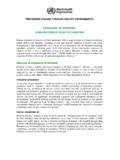Transcription of Dosage and administration - Medsafe
1 Data Sheet New Zealand DBL cytarabine INJECTION. Presentation DBL cytarabine Injection 20 mg/mL, 50 mg/mL and 100 mg/mL is a clear colourless sterile solution of cytarabine BP in Water for Injections. Uses Actions cytarabine is an antineoplastic agent. cytarabine is a synthetic pyrimidine nucleoside, which is converted intracellularly to the nucleotide, cytarabine triphosphate. The exact mechanism of action of cytarabine is not fully understood, but cytarabine triphosphate appears to inhibit DNA synthesis by the inhibition of DNA polymerase. The enzyme responsible for this conversion is deoxycytidine kinase which is found predominantly in the liver and possibly the kidney.
2 cytarabine is inactivated by the enzyme cytidine deaminase found in the intestine, kidney and liver. The ratio of the activating enzyme (deoxycytidine kinase) to the inactivating enzyme (cytidine deaminase) in cells, determines the susceptibility of the tissue to the cytotoxic effects of cytarabine . Tissues with a high susceptibility have high levels of the activating enzyme. cytarabine 's actions are cell-cycle specific as it has no effect on non-proliferating cells, or on proliferating cells unless in the S or DNA synthesis phase. cytarabine is also immunosuppressant and has demonstrated antiviral activity in vitro; however efficacy against herpes zoster or smallpox could not be demonstrated in controlled clinical trials.
3 cytarabine is cytotoxic to a wide variety of proliferating mammalian cells in culture. It exhibits cell phase specificity, primarily killing cells undergoing DNA synthesis (S-phase) and under certain conditions blocking the progression of cells from the G1 phase to the S-phase. A limited, but significant, incorporation of cytarabine into both DNA and RNA has also been reported. Extensive chromosomal damage, including chromatoid breaks, have been produced by cytarabine and malignant transformation of rodent cells in culture has been reported. Deoxycytidine prevents or delays (but does not reverse) the cytotoxic activity.
4 Pharmacokinetics Absorption: cytarabine is not effective when administered orally, less than 20% of a dose is absorbed from the gastrointestinal tract and is ineffective by this route. Subcutaneously or intramuscularly, tritium labelled cytarabine produces peak plasma concentrations of radioactivity within 20 60 minutes and are considerably lower than those attained after intravenous administration . Continuous intravenous infusions produce relatively constant plasma levels in 8 24 hours. Distribution: It is rapidly and widely distributed into tissues including liver, plasma and peripheral granulocytes.
5 cytarabine crosses the blood-brain barrier to a limited extent and also apparently crosses the placenta. It is not known if cytarabine is distributed into breast milk. Cerebrospinal fluid levels of cytarabine are low in comparison to plasma levels after single intravenous injection. However, in one patient in whom cerebrospinal levels were examined after 2 hours of constant intravenous infusion, levels approached 40 percent of the steady state plasma level. With intrathecal administration , levels of cytarabine in the cerebrospinal fluid declined with a first order half-life of about 2.
6 Hours. Because cerebrospinal fluid levels of deaminase are low, little conversion to ara-U was observed. Metabolism: Metabolism occurs also in the kidneys, gastrointestinal mucosa, granulocytes and other tissues. cytarabine is rapidly metabolised, mainly in the liver, to the inactive metabolite 1- -D-arabinofuranosyluracil. Elimination/Excretion: After rapid IV injection, plasma concentrations of cytarabine appear to decline in a biphasic manner with an initial distribution half-life of about 10 minutes, followed by a secondary elimination half-life of about 1-3 hours.
7 About 70 to 80% of a dose is excreted in the urine of a dose administered by any route within 24 hours;. approximately 90% as the metabolite and 10% as unchanged cytarabine . Hosp 1. Data Sheet New Zealand Immunosuppressive Action cytarabine is capable of obliterating immune responses in man during administration with little or no accompanying toxicity. Suppression of antibody responses to antigen and tetanus toxoid have been demonstrated. This suppression was obtained during both primary and secondary antibody responses. cytarabine also suppressed the development of cell-mediated immune responses such as delayed hypersensitivity skin reaction to dinitrochlorobenzene.
8 However, it had no effect on already established delayed hypersensitivity reactions. Following 5-day courses of intensive therapy with cytarabine the immune response was suppressed, as indicated by the following parameters: macrophage ingress into skin windows; circulating antibody response following primary antigenic stimulation; lymphocyte blastogenesis with phytohaemaglutinin. A. few days after termination of therapy there was a rapid return to normal. Indications cytarabine may be used alone or in combination with other chemotherapeutic agents. It is indicated for induction of remission of leukaemia, particularly for acute myeloid leukaemia, in adults and children.
9 cytarabine has been used for remission induction in acute lymphocytic leukaemia, chronic myeloid leukaemia and erythroleukaemia; and in the treatment and maintenance therapy of meningeal leukaemia and other meningeal neoplasms. Children with non-Hodgkin's lymphoma have benefitted from a combination drug programme (LSA2L2). that includes cytarabine . Dosage and administration Being orally inactive, cytarabine is administered by a variety of parenteral routes: subcutaneously, intravenously either as a bolus push or as a continuous infusion, or intrathecally. : DBL cytarabine Injection 100 mg/mL is hypertonic and therefore unsuitable for intrathecal use.
10 Thrombophlebitis has occurred at the site of drug injection or infusion in some patients. Pain and inflammation at subcutaneous injection sites are rare. Subcutaneous injection sites should be rotated around the areas of body fat: the abdomen, thighs and flank region. The drug is generally well tolerated in most instances. Higher total doses can be better tolerated when administered by rapid IV injection as compared to slow infusion. Such a phenomenon can be explained by the rapid inactivation of the drug and the brief exposure of susceptible normal neoplastic cells to significant levels after rapid injection.
















